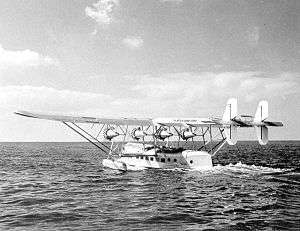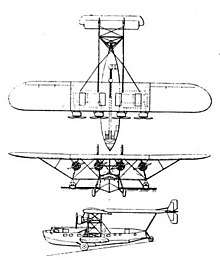Sikorsky S-40
| S-40 | |
|---|---|
 | |
| Sikorsky S-40 PanAm 1931 | |
| Role | Amphibious flying boat |
| National origin | United States |
| Manufacturer | Sikorsky Aircraft |
| First flight | 1931 |
| Introduction | August 7, 1931 |
| Primary user | Pan American |
| Number built | 3 |
| Unit cost |
$125,000 in 1931 |
| Developed into | Sikorsky S-42 |
The Sikorsky S-40 was an American amphibious flying boat built by Sikorsky in the early 1930s for Pan American World Airways.
Design and development
Sikorsky designed the S-40 in response to a request from Juan Trippe, president of Pan American Airways, for a larger passenger carrying airplane. The S-40s could carry 38 passengers, a significant increase over the S-38's capacity of eight passengers. The aircraft featured a pantry with an electric refrigerator and stove as well as beautifully appointed smoking lounge with book-ended mahogany wood paneling. Six life rafts were carried on board.[1] Despite its significant capacity increase, the S-40s were not the most aerodynamic aircraft due in large part to the numerous flying wires and strut braces that were used as an exterior support framework, hence the nickname "Flying Forest". Only three were built as Sikorsky was designing (during the maiden flight of the S-40) and building the more modern S-42 as a replacement aircraft.
A total of three aircraft were built by the Vought-Sikorsky Aircraft Division of the United Aircraft Corporation in Stratford, Connecticut. The three aircraft in the S-40 series were:
- NC80V – American Clipper
- NC81V – Caribbean Clipper
- NC752V – Southern Clipper
In 1935 a new version, the Sikorsky S-40A, was created by upgrading the original three aircraft. Their 575 hp (429 kW) Pratt & Whitney R-1860 Hornet B engines were replaced by smaller, heavily supercharged 660 hp (490 kW) R-1690 Hornet T2D1 engines, the landing gear was eliminated, and the maximum weight was slightly increased.
Operational history
Passenger carrying service was initiated on the November 19, 1931, with a S-40 piloted by Charles Lindbergh, flying from Miami, Florida to the Panama Canal Zone with stops at Cienfuegos, Cuba; Kingston, Jamaica, and Barranquilla, Colombia.
The S-40 was Pan American's first large flying boat. The American Clipper served as the flagship of Pan Am's clipper fleet and this aircraft model was the first to earn the popular designation of "Clipper" or "Pan Am Clipper". The three S-40s served without incident during their civilian lives, flying a total of over 10 million miles. They were turned over to the US Navy during World War II and were used as trainers for four-engined flight instruction. All three of the S-40s were eventually retired and scrapped starting in 1943.
Specifications (S-40)

Data from American airplane specifications[2]
General characteristics
- Crew: 6 crew
- Capacity: 38 passengers
- Length: 76 ft 0 in (23.16 m)
- Wingspan: 114 ft 0 in (34.75 m)
- Height: 23 ft 0 in (7.01 m)
- Wing area: 1,740 sq ft (162 m2)
- Empty weight: 23,000 lb (10,433 kg)
- Gross weight: 34,000 lb (15,422 kg)
- Fuel capacity: 1,066 US gal (888 imp gal; 4,040 L)
- Powerplant: 4 × Pratt & Whitney Hornet 9-cylinder radial engines, 575 hp (429 kW) each
Performance
- Maximum speed: 117 kn; 217 km/h (135 mph)
- Cruise speed: 97 kn; 180 km/h (112 mph)
- Stall speed: 56 kn; 103 km/h (64 mph)
- Range: 782 nmi; 1,448 km (900 mi)
- Service ceiling: 13,000 ft (4,000 m)
- Rate of climb: 700 ft/min (3.6 m/s)
See also
Related development
Related lists
References
Notes
Bibliography
- "American airplane specifications". Aviation, Vol. 32, No. 1, January 1933, pp. 28–32. Registration required.
- Davies, R.E.G. Pan Am: An Airline and its Aircraft. New York: Orion Books, 1987. ISBN 0-517-56639-7.
- Yenne, Bill. Seaplanes & Flying Boats: A Timeless Collection from Aviation's Golden Age. New York: BCL Press, 2003. ISBN 1-932302-03-4.
External links
| Wikimedia Commons has media related to Sikorsky S-40. |
- "World's Largest Amphibian Takes Flight", Popular Science, October 1931
- The Sikorsky S-40 in the film Flying Down to Rio
- "Huge Amphibian Will Carry Forty-Six Passengers" Popular Mechanics, July 1931 article and photos of construction of first S-40.
- "This Sea Going Airliner Is Like A Clipper Ship", Popular Mechanics, September 1931, early cutaway drawing on announcement of construction
- "Luxuries Found In Air Travel On Huge U.S. Planes", Popular Mechanics, July 1932, interior of S-40 showing passenger accommodations